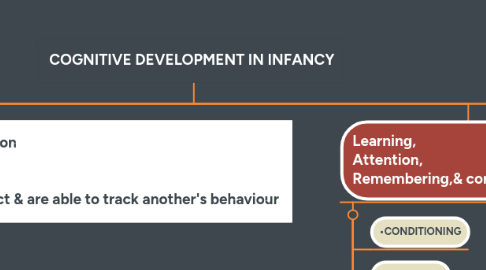
1. 1. SCHEMES: action or mental representation that organize knowledge ex= sucking,looking &grasping 2.ASSIMILATION: children use thier existing schemes to deal with new imformation / experience .ACCOMODATION: children adjust their schemes to take new imformation & experience. 3.ORGANIZATION: grouping isolated behaviours /item into a higher order cognitive system 4.EQUILIBRATION: mechanism by which children shift from one stage of thought to the next -Disequilibrium -equilibrium
1.1. •sensorimotor stage
1.1.1. 1. SIMPLE REFLEXES 2.FIRST HABBIT & PRIMARY CIRCULAR REACTION 3.SECONDARY CIRCULAR REACTIONS 4.COORDINATION OF SECONDARY CIRCULAR REACTION 5.TERTIARY CIRCULAR REACTIONS,NOVELTY & CURIOSITY 6.INTERNALIZATION OF SCHEMES
1.1.1.1. •EVALUATING PIAGET'S SENSORIMOTOR STAGE
1.1.1.2. 1. THE A-NOT-B ERROR 2.PERCEPTUAL DEVELOPMENT & EXPECTATIONS 3.THE NATURE-NUTURE ISSUE
2. Piaget's theory of infant developmet
2.1. •cognitive processes
3. Learning, Attention, Remembering,& conceptualizing
3.1. •CONDITIONING
3.2. •ATTENTION
3.3. •MEMORY
3.3.1. -MEMORY : central feature of cognitive development,pertaining to all situation s in which and individual retains information ove time -IMPLICT MEMORY: memory without conscious recollecting -EXPLICIT MEMORY: conscious remembering of facts & experiences
3.4. •IMITATION
3.4.1. Infant's imitative abilitiesdo not resemble a hardwired response but rather involve flexibility & adaptability
3.5. •CONCEP FORMATION & CATEGORIZATION
3.6. : consequences of a behavior produce changes in the probablity of the behavior's occurrence
4. Langguage developmet
4.1. •DEFINING LANGUAGE
4.1.1. Is a form communication -whether spoken,written / signed-that is based on a system of symbols -INFINITE GENERATIVITY: ability to produce & ckmprehend an endless number of meaningfull sentences usinf a finite set of word & rules
4.2. •LANGUAGE'S RULE SYSTEMS
4.2.1. 1.PHONOLOGY -. sound system of the langguage,including the sounds that are used & how they may be combined 2.MORPHOLOGY-. Units of meaning involved in word formation 3.SYNTAX-. ways word are combined to form acceptable phrase & sentences 4.SEMANTICS-. Meaning of words & sentences 5.PRAGMATICS-. appropriate use of langguage in different contexts
4.3. •HOW LANGGUAGE DEVELOPS
4.3.1. 1. RECOGNIZING LANGGUANGE SOUNDS 2.BABBLING & OTHER VOCALIZATIONS 3.GESTURES 4.FIRST WORDS 5. 2 WORD UTTERANCES
4.3.1.1. •BIOLOGICAL & ENVIRONMENTAL INFLUENCES
4.3.1.2. 1. BIOLOGICAL INFLUENCES: ability to speak & understand langguage. >broca's area >wernicke's area >aphasia >LAD 2. ENVIRONMENTAL INFLUENCES : our coverage of environmental influences on langguange development. >the role of social interaction >child-directed speech & other caregiver strategies

